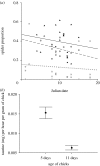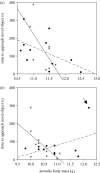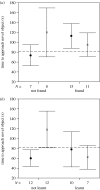Parental prey selection affects risk-taking behaviour and spatial learning in avian offspring
- PMID: 17698490
- PMCID: PMC2275882
- DOI: 10.1098/rspb.2007.0687
Parental prey selection affects risk-taking behaviour and spatial learning in avian offspring
Abstract
Early nutrition shapes life history. Parents should, therefore, provide a diet that will optimize the nutrient intake of their offspring. In a number of passerines, there is an often observed, but unexplained, peak in spider provisioning during chick development. We show that the proportion of spiders in the diet of nestling blue tits, Cyanistes caeruleus, varies significantly with the age of chicks but is unrelated to the timing of breeding or spider availability. Moreover, this parental prey selection supplies nestlings with high levels of taurine particularly at younger ages. This amino acid is known to be both vital and limiting for mammalian development and consequently found in high concentrations in placenta and milk. Based on the known roles of taurine in mammalian brain development and function, we then asked whether by supplying taurine-rich spiders, avian parents influence the stress responsiveness and cognitive function of their offspring. To test this, we provided wild blue tit nestlings with either a taurine supplement or control treatment once daily from the ages of 2-14 days. Then pairs of size- and sex-matched siblings were brought into captivity for behavioural testing. We found that juveniles that had received additional taurine as neonates took significantly greater risks when investigating novel objects than controls. Taurine birds were also more successful at a spatial learning task than controls. Additionally, those individuals that succeeded at a spatial learning task had shown intermediate levels of risk taking. Non-learners were generally very risk-averse controls. Early diet therefore has downstream impacts on behavioural characteristics that could affect fitness via foraging and competitive performance. Fine-scale prey selection is a mechanism by which parents can manipulate the behavioural phenotype of offspring.
Figures



References
-
- Aerts L, Assche F.A.V. Taurine and taurine-deficiency in the perinatal period. J. Perinat. Med. 2002;30:281–286. doi:10.1515/JPM.2002.040 - DOI - PubMed
-
- Arnold K.E, Blount J.D, Metcalfe N.B, Orr K.J, Adam A, Houston D, Monaghan P. Sex-specific differences in compensation for poor neonatal nutrition in the zebra finch Taeniopygia guttata. J. Avian Biol. 2007;38:356–366. doi:10.1111/j.0908-8857.2007.03818.x - DOI
-
- Betts M.M. The food of titmice in oak woodland. J. Anim. Ecol. 1955;24:282–323. doi:10.2307/1715 - DOI
-
- Blount J.D, Metcalfe N.B, Arnold K.E, Surai P.F, Devevey G.L, Monaghan P. Neonatal nutrition, adult antioxidant defences and sexual attractiveness in the zebra finch. Proc. R. Soc. B. 2003;270:1691–1696. doi:10.1098/rspb.2003.2411 - DOI - PMC - PubMed
-
- Carere C, Drent P.J, Koolhaas J.M, Groothuis T.G.G. Epigenetic effects on personality traits: early food provisioning and sibling competition. Behaviour. 2005;142:1329–1355. doi:10.1163/156853905774539328 - DOI
Publication types
MeSH terms
Substances
LinkOut - more resources
Full Text Sources
